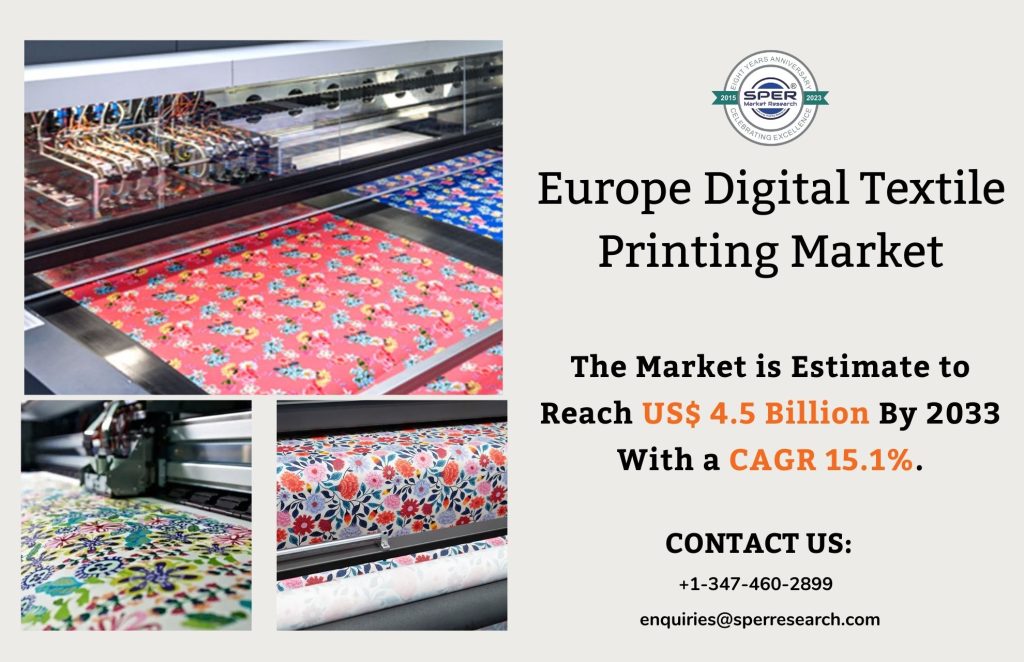Europe Digital Textile Printing Market Growth 2024- Industry Share, Upcoming Trends, Revenue, Challenges, Future Opportunities and Forecast till 2033: SPER Market Research

Digital textile printing is considered the next phase of printing, as opposed to traditional fabric printing. The rapid digital transformation of the textile sector has prompted many textile entrepreneurs to invest in digital printing technology. It is also suitable for those who enjoy experimenting with bold and unique designs, such as fashion designers.
According to SPER market research, Europe Digital Textile Printing Market Size- By Substrate Type, By Ink Type, By End Use- Regional Outlook, Competitive Strategies and Segment Forecast to 2033 state that the Europe Digital Textile Printing Market is predicted to reach USD 4.5 Billion by 2033 with a CAGR of 15.1%.
DRIVING FACTORS:
Growing Demand for Customised Textiles: In Europe, consumers are increasingly looking for personalised and distinctive textile items, which is boosting demand for digital printing machines that can accommodate particular design preferences.
Emphasis on sustainable practices: The European textile industry prioritises sustainability and ecologically responsible techniques. Digital textile printing, with its lower water usage and eco-friendly ink alternatives, is consistent with these sustainability aims.
The Rise of E-Commerce: The rise of e-commerce platforms has fueled the need for on-demand and customisable textiles. Digital textile printing machines play an important role in addressing the needs of online businesses and their demanding clients.
Technological Advances: Continuous developments in digital printing technology, such as improved printheads, quicker printing speeds, and superior colour management, are increasing acceptance of digital textile printing machines in Europe.
CHALLENGES:
Initial Investment expenses: The initial expenses of purchasing and installing digital textile printing machines might be prohibitive for small and medium-sized businesses (SMEs). However, the long-term cost reductions and advantages frequently exceed the initial investment.
Limited Colour Fastness: While digital textile printing allows for colourful and elaborate graphics, some issues with colour fastness on specific textiles may be a constraint. Manufacturers are actively attempting to create more durable and colorfast ink formulas.
Technological intricacy: Due to the intricacy of digital printing technology, operators may require additional training. Having qualified personnel capable of managing and maintaining these devices is critical for achieving peak performance.
Compatibility with Different Fabrics: Maintaining consistent print quality over a wide range of fabrics can be challenging. Manufacturers must engage in research and development to ensure that digital textile printing machines work with a wide range of textiles.
Request For Free Sample Report @ https://www.sperresearch.com/report-store/europe-digital-textile-printing-market.aspx?sample=1
Impact of COVID-19 on Europe Digital Textile Printing Market
COVID Impact: The COVID-19 epidemic had a significant influence on the global textile industry, with widespread ramifications owing to shipping limitations and supply chain disruption. With China serving as a primary manufacturing base and supplier of textile materials worldwide, disruptions in its operations had a ripple effect throughout the industry, particularly in Europe. This resulted in a considerable decline in trade values. In response, numerous major European corporations shifted production orders meant for China to Turkey, Morocco, Portugal, and Spain. Italy, famed for its industrial printing leadership in Europe, had significant economic consequences as a result of COVID-19 and subsequent lockdowns, exacerbating financial troubles for much of the region’s textile printing industry.
Italy dominates the European digital textile printing industry, owing to increased demand for digital textile printing in Italy’s fashion industries. Furthermore, the enormous number of fashion industries in Milan, Rome, Palermo, and Venice drives demand for customised digital textile printing with a wide range of colour combinations and trendy designs. Furthermore, the presence of firms offering novel textile printing solutions, such as EFI Reggiani, and Italian-based J-Teck3, which provides sophisticated dye sublimation and disperse digital textile inks, is projected to boost market expansion.
Europe Digital Textile Printing Market Key Players:
Additionally, some of the market key players are Atpcolor, Atexco, Dover Corporation, Epson, Efi Reggiani, Hollanders Printing Systems B.V., Others.
Europe Digital Textile Printing Market Segmentation:
The SPER Market Research report seeks to give market dynamics, demand, and supply forecast for the years up to 2033. This report contains statistics on product type segment growth estimates and forecasts.
By Substrate Type: Based on the Substrate Type, Europe Digital Textile Printing Market is segmented as; Cotton, Polyester, Silk, Others.
By Ink Type: Based on the Ink Type, Europe Digital Textile Printing Market is segmented as; Acid, Direct Dispense, Pigments, Reactive, Sublimation, Others.
By End Use: Based on the End Use, Europe Digital Textile Printing Market is segmented as; Clothing, Display, Household, Technical Textiles, Others.
By Region: This research also includes data for Germany, France, the UK, Spain, Italy, Turkey, Russia, Poland, Switzerland, Sweden, Norway, The Netherlands, Greece and Rest of Europe.
This study also encompasses various drivers and restraining factors of this market for the forecast period. Various growth opportunities are also discussed in the report.
For More Information, refer to below link:-
Europe Digital Textile Printing Market Revenue
Related Reports:
Follow Us –
LinkedIn | Instagram | Facebook | Twitter
Contact Us:
Sara Lopes, Business Consultant – U.S.A.
SPER Market Research
+1-347-460-2899





